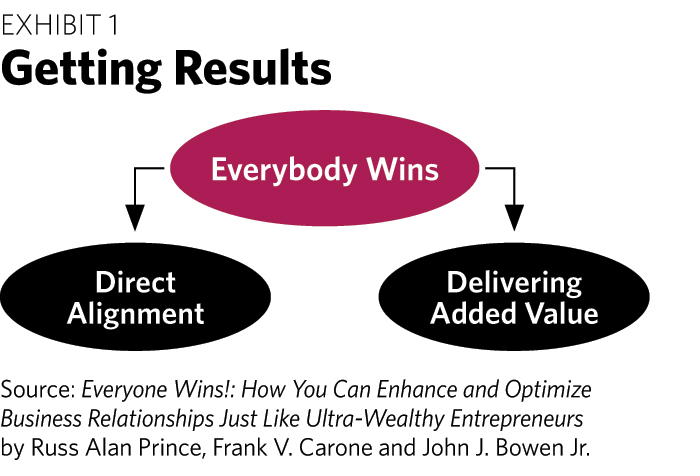In the same way, you need to clearly specify the real interests of the five people you identified. If you feel you don’t have sufficient answers, write down where the gaps are and what you need to ask in order to gain a more cohesive understanding. Very often, I’m finding that financial advisors have to go back and get more information to develop it.
Getting Results
Now that you understand where you stand with your own interests and other people’s, you have to uncover ways to help them achieve their goals.
Your insights into them will show you the way. There are two approaches to getting results—by directly aligning with someone or by helping them by adding value.
 For example, if you’ve determined that a lawyer is “hungry” for more business and operating within a traditional law firm business model (and is not completely locked into that model), you can usually show him or her how to increase annual revenues by at least 25% with financial products such as sophisticated qualified retirement plans for their business owner clients. This kind of help addresses both the lawyer’s interests and yours. Both of you will make significantly more money while better serving the lawyer’s entrepreneur clients. With some practice, finding areas of overlap between your interests and somebody else’s gets pretty easy.
For example, if you’ve determined that a lawyer is “hungry” for more business and operating within a traditional law firm business model (and is not completely locked into that model), you can usually show him or her how to increase annual revenues by at least 25% with financial products such as sophisticated qualified retirement plans for their business owner clients. This kind of help addresses both the lawyer’s interests and yours. Both of you will make significantly more money while better serving the lawyer’s entrepreneur clients. With some practice, finding areas of overlap between your interests and somebody else’s gets pretty easy.
At other times, the answer is less obvious—when there isn’t any overlap between your interests and the other person’s. In that case, you have to find ways to add value to the relationship. One very effective approach is to offer the other professional high-value thought leadership content they can use with clients and prospects. You’ll likely need to coach them on how to use this content to generate more business. The law of reciprocity suggests that their success, coupled with your guidance, will motivate them to direct their “better” clients to you for your expertise.
Tracking Results
Again consider the five people you wanted to work with. You want to make sure you’re getting the outcomes you’re looking for. Therefore, you need to track results. If, for example, you’re targeting $250,000 in new business from an accountant and that’s not happening, you probably want to reconsider working with that professional—even if you’re getting more referrals than before.
But you’ll also want to know if your efforts are helping others get what they want.
In one situation, I helped a non-U.S. private client lawyer add about $2 million to her annual income (not revenue). This outcome greatly exceeded her expectations, and it led to a discussion where she now takes a very proactive approach to introducing her ultra-wealthy and single-family office clients to me. She knew that our work together was fruitful for her, but she didn’t know how fruitful until I showed her.
What Holds Financial Professionals Back
Unfortunately, this process seems to be outside the comfort zone of some financial professionals who see their value as a function of their asset allocation model or investment style or technical wealth planning expertise.
I was on a videoconference call with a wealth manager, who has about a half billion in assets under management, and a high-end accountant he was looking to get referrals from. While he’s known the accountant for more than a decade, he’s never received a single referral, even though he has sent clients to the accountant year in and year out.
I had spent some time ascertaining what the accountant’s interests were, concentrating on ways he could deliver greater value to his wealthier clients. We thought of ways the wealth manager could offer products that would also generate additional business for the accountant. We got into the trenches and found six good potential client candidates (each with a net worth of $30 million or more). During the call, the wealth manager said (and this is a direct quote): “Let’s stop talking about clients and let me explain my investment philosophy.” The videoconference ended about 10 minutes later and no referrals were ever made to the wealth manager.
Russ Alan Prince is president of R.A. Prince & Associates.








